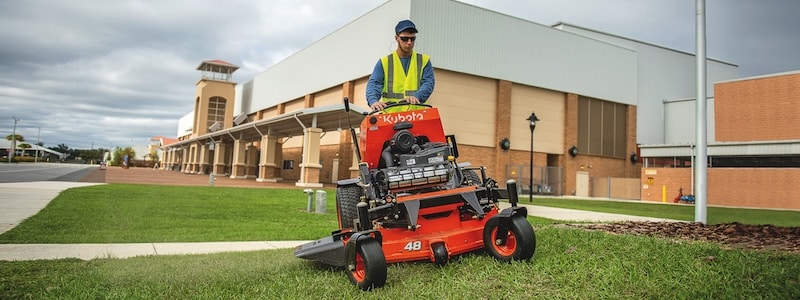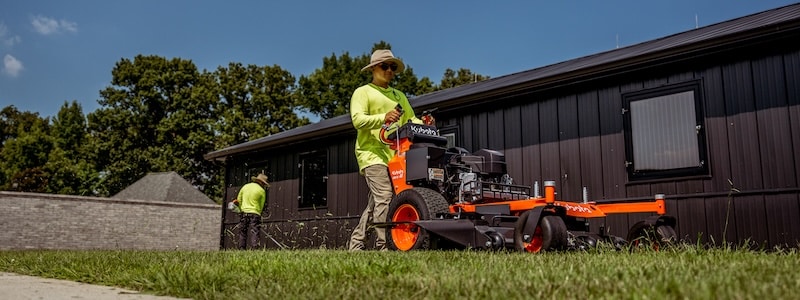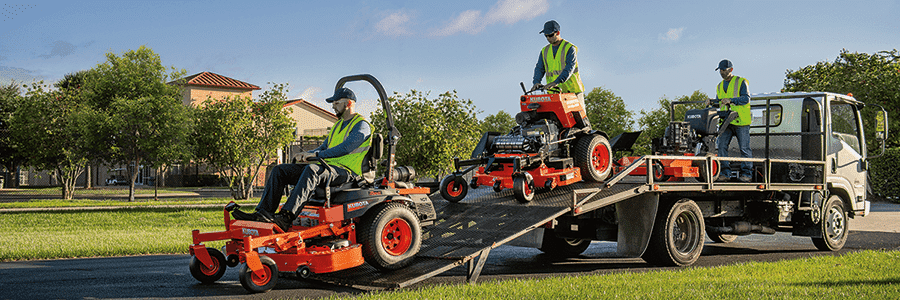Every season somebody asks the same question. Should I get a stand-on or a walk-behind? Both will cut grass fine. The difference is how you like to work and the size of the lawn. Stand-on mowers are faster. Walk-behinds are steadier. That’s the short version. If you want the long version, keep reading!
What is a Stand-On Mower?

A stand-on mower, or standing lawn mower, has a small platform where you stand behind the deck. It runs like a zero-turn with two control levers that move the hydraulic pumps and wheel motors. You stand right over the drive tires so you’ve got good traction and can see what’s in front of you.
These machines turn on a dime. You can spin it around, go forward or backward quick, and load it on a trailer without much fuss. That saves time, especially if you’re cutting several yards a day. They also move faster between jobs. Once you get used to standing while mowing, you probably won’t want to go back.
Pros:
- Fast and easy to move around
- Small size for trailers and storage
- Simple to hop off when needed
- Less tiring than walking all day
Cons:
- Costs more to buy
- Takes some skill on steep ground
Best For: Bigger lawns or commercial work where you’re mowing several acres
What is a Walk-Behind Mower?

Walk-behind mowers are the old standard. They’re simple, tough, and steady. You steer from behind with levers or pistol grips that control wheel speed. Some people add a sulky so they can ride behind it, though that’s better on flat ground.
Most walk-behinds use either a belt drive or a hydro drive. Belt drives are cheaper but need more upkeep. Hydro drives give smoother control and variable speed. If you’re mowing small lawns or steep spots, a hydro walk-behind handles better than almost anything else.
Because you’re walking, your weight isn’t on the mower. That means less compaction on soft turf and better traction on slopes. The tradeoff is slower speed, but you get a clean finish and less turf damage.
Pros:
- Great traction on hills
- Smooth, even cut
- Easy to service
- Lower price
Cons:
- Slower for large areas
- Harder on your legs without a sulky
Best For: Small lawns, hills, and anyone who wants full control over the cut
Stand-On vs. Walk-Behind: A Closer Look
Speed/Productivity
Stand-on mowers win on speed. If you mow more than an acre, you’ll notice the time savings right away. Crews that switch to standers usually get through more lawns per day.
Maneuverability
Standing mowers are quick to turn and see around. The shorter frame helps when you’re weaving through trees or beds. Walk-behinds still do better in tight spaces where you need to trim close without tearing grass.
Operator Fatigue
Standing all day beats walking miles behind a mower. Still, walk-behinds feel steadier on rough ground. Some crews mix it up, using standers for flat lawns and walk-behinds for slopes.
Terrain/Turf Impact
Walk-behinds are lighter so they’re easier on wet or soft lawns. Stand-up mowers weigh more per inch of contact but have better balance than a sit-down zero-turn. That even weight helps reduce spinning and tearing grass when turning.
Maintenance/Cost
Walk-behinds are simpler to fix. Belts and bearings are easy to get to. Standing lawn mowers cost more to service since they use hydraulic drive systems, but the speed and time savings often make up for it if you mow a lot.
Residential/Commercial Use
If your lawn is under an acre, a walk-behind probably makes sense. It’s cheaper, smaller, and gives a nice clean cut. If you mow a few acres, a stand-on is worth it. Faster ground speed means you’ll be done in half the time. For large crews or commercial jobs, stand-on lawn mowers are the way to go since you can fit more machines on one trailer and get through more yards in a day.
Learn more in our lawn mower comparison chart.

Expert Advice
If you’re mowing several lawns get a stand-on mower. If it’s your yard and it’s small or hilly go with a walk-behind. Don’t rush the learning curve on either. Take time to get used to how it turns and handles slopes. And always check your blades, belts, and tire pressure before you start. That’ll save you headaches later.
Read now: 5 Tips for Selecting the Right Kubota Mower
A Bit of History
Walk-behinds came first. They evolved from two-wheel tractors people used for slopes and tight areas. Simple machines that got the job done. Stand-ons came along after, mixing zero-turn speed with walk-behind control. They caught on fast with pros who wanted more output without buying full-size riders.
Find Your Match at Bobby Ford Tractor and Equipment
Bobby Ford Tractor and Equipment has both styles. You can see them in person at our dealership in Angleton, Texas, or look at our mower models online. Either way, our trusted Kubota dealer team is available to walk you through how each one runs and help you pick what fits your property and work style.
Click to call or see our contact info here.
The content on this site reflects my own opinions and does not necessarily reflect the views or opinions of my employer or Kubota Tractor Corporation.
